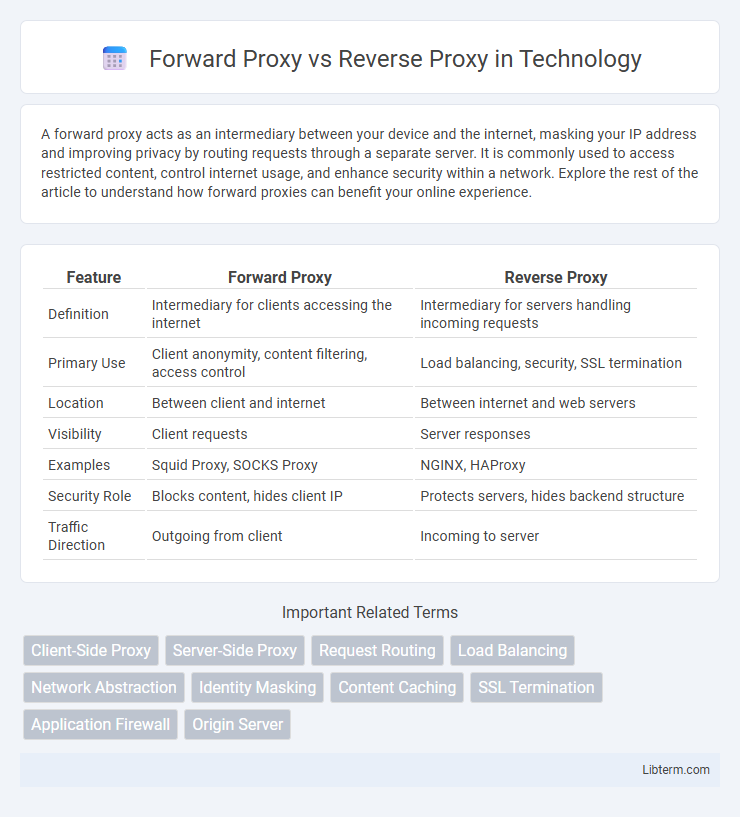A forward proxy acts as an intermediary between your device and the internet, masking your IP address and improving privacy by routing requests through a separate server. It is commonly used to access restricted content, control internet usage, and enhance security within a network. Explore the rest of the article to understand how forward proxies can benefit your online experience.
Table of Comparison
| Feature | Forward Proxy | Reverse Proxy |
|---|---|---|
| Definition | Intermediary for clients accessing the internet | Intermediary for servers handling incoming requests |
| Primary Use | Client anonymity, content filtering, access control | Load balancing, security, SSL termination |
| Location | Between client and internet | Between internet and web servers |
| Visibility | Client requests | Server responses |
| Examples | Squid Proxy, SOCKS Proxy | NGINX, HAProxy |
| Security Role | Blocks content, hides client IP | Protects servers, hides backend structure |
| Traffic Direction | Outgoing from client | Incoming to server |
Introduction to Proxies: Forward vs Reverse
Forward proxies act as intermediaries for clients seeking resources from external servers, masking the client's identity and controlling outbound traffic to enhance privacy and security. Reverse proxies sit in front of web servers, managing inbound client requests by distributing load, caching content, and offering protection against attacks such as DDoS. Both proxies optimize network performance but serve distinct roles: forward proxies govern client-to-server communication, while reverse proxies manage server-to-client interactions.
What is a Forward Proxy?
A forward proxy acts as an intermediary between a client and the internet, masking the client's IP address to enhance privacy and control over outbound requests. It handles requests from internal users seeking access to external resources, commonly used for web filtering, content control, and anonymous browsing. Forward proxies improve network security by managing and monitoring outbound traffic on behalf of clients within a private network.
What is a Reverse Proxy?
A reverse proxy is a server positioned between client devices and backend servers, handling incoming requests on behalf of those servers. It enhances security, load balancing, and caching by intercepting client requests, forwarding them to appropriate backend servers, and returning the responses. Common uses include protecting web servers, distributing traffic across multiple servers, and improving application performance through content optimization.
Key Differences Between Forward and Reverse Proxies
Forward proxies act as intermediaries between client devices and external servers, primarily used to filter requests, improve security, and cache content on behalf of clients. Reverse proxies sit in front of web servers, managing incoming traffic, load balancing, SSL termination, and protecting backend servers from direct exposure. The key differences lie in their positioning and purpose: forward proxies serve client interests by masking client identity, while reverse proxies protect and optimize servers by intercepting requests before they reach internal resources.
Use Cases for Forward Proxies
Forward proxies serve as intermediaries between clients and the internet, primarily used to enforce corporate internet policies, such as content filtering and access control. They enhance security and privacy by masking client IP addresses and caching frequently accessed web content to improve load times and reduce bandwidth usage. Common use cases include controlling employee internet usage, bypassing geo-restrictions, and monitoring outbound traffic for threat detection.
Use Cases for Reverse Proxies
Reverse proxies serve as intermediaries that handle incoming client requests, improving security and load balancing for web servers. Common use cases include distributing traffic across multiple backend servers to enhance performance, caching content to reduce latency, and providing an additional security layer by hiding the origin server's IP address. Enterprises leverage reverse proxies like Nginx and HAProxy for SSL termination, DDoS protection, and centralized logging, optimizing web application reliability and scalability.
Advantages and Disadvantages of Forward Proxies
Forward proxies enhance user privacy by masking IP addresses and enable content filtering to control access to external sites, improving security for internal networks. However, they can introduce latency and bottlenecks due to additional processing, and improper configuration may lead to security vulnerabilities or unauthorized access. Despite these drawbacks, forward proxies remain valuable for controlling outbound traffic and enforcing organizational policies.
Advantages and Disadvantages of Reverse Proxies
Reverse proxies enhance security by masking backend servers and filtering client requests, effectively protecting against attacks and unauthorized access. They improve load balancing and caching, leading to faster response times and better resource management. However, reverse proxies can introduce latency, represent a single point of failure, and add complexity to network architecture and SSL/TLS certificate management.
Security Implications: Forward vs Reverse Proxies
Forward proxies enhance client privacy by masking IP addresses and controlling outbound traffic, reducing exposure to external threats. Reverse proxies protect backend servers by filtering incoming requests, blocking malicious attacks such as DDoS, and enforcing security policies at the network edge. While forward proxies primarily secure client-side communications, reverse proxies safeguard server infrastructure and optimize application delivery.
Choosing the Right Proxy for Your Needs
Choosing the right proxy depends on your specific use case: forward proxies are ideal for client-side needs such as anonymizing user requests or accessing geo-restricted content, while reverse proxies optimize server-side tasks like load balancing, security, and caching at the web server level. Forward proxies mask client IP addresses and control outbound traffic, making them essential for privacy and content filtering. Reverse proxies, positioned in front of web servers, protect against DDoS attacks and improve performance by distributing inbound requests across multiple backend servers.
Forward Proxy Infographic

 libterm.com
libterm.com